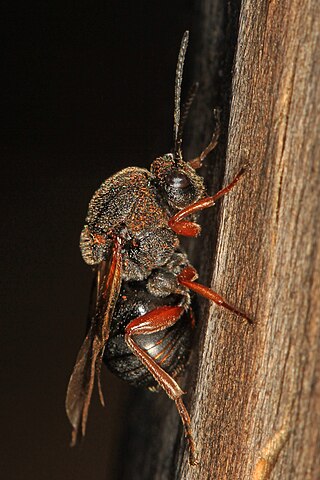
Chalcid wasps are insects within the superfamily Chalcidoidea, part of the order Hymenoptera. The superfamily contains some 22,500 known species, and an estimated total diversity of more than 500,000 species, meaning the vast majority have yet to be discovered and described. The name "chalcid" is often confused with the name "chalcidid", though the latter refers strictly to one constituent family, the Chalcididae, rather than the superfamily as a whole; accordingly, most recent publications (e.g.,) use the name "chalcidoid" when referring to members of the superfamily.

Diplolepis is a genus of approximately fifty species of gall-inducing wasps in the family Diplolepididae. The larvae induce galls on wild roses (Rosa), and rarely on domestic roses.

Gall wasps, also traditionally calledgallflies, are hymenopterans of the family Cynipidae in the wasp superfamily Cynipoidea. Their common name comes from the galls they induce on plants for larval development. About 1,300 species of this generally very small creature are known worldwide, with about 360 species of 36 different genera in Europe and some 800 species in North America.

The Pteromalidae are a large family of wasps, the majority being parasitoids of other insects. They are found throughout the world in virtually all habitats, and many are important as biological control agents. The oldest known fossil is known from the Early Cretaceous.

The Cynipoidea are a moderate-sized hymenopteran superfamily that presently includes seven extant families and three extinct families, though others have been recognized in the past. The most familiar members of the group are phytophagous, especially as gall-formers, though the actual majority of included species are parasitoids or hyperparasitoids. They are typically glossy, dark, smooth wasps with somewhat compressed bodies and somewhat reduced wing venation. It is common for various metasomal segments to be fused in various ways, and the petiole is very short, when present.

The common spangle gall on the underside of leaves and the currant gall on the male catkins or occasionally the leaves, develop as chemically induced distortions on pedunculate oak, or sessile oak trees, caused by the cynipid wasp Neuroterus quercusbaccarum which has both agamic and bisexual generations.

Galeopsomyia is a New World genus of hymenopteran insects of the family Eulophidae. The genus is a hyperparasitoid of other gall-inducing wasps of the genera Eurytoma and Torymus.

Cynipini is a tribe of gall wasps. These insects induce galls in plants of the beech and oak family, Fagaceae. They are known commonly as the oak gall wasps. It is the largest cynipid tribe, with about 936 to 1000 recognized species, most of which are associated with oaks. The tribe is mainly native to the Holarctic.

Ormocerinae is a subfamily in the chalcidoid wasp family Pteromalidae.

Andricus quercuscalifornicus, or the California gall wasp, is a small wasp species that induces oak apple galls on white oaks, primarily the valley oak but also other species such as Quercus berberidifolia. The California gall wasp is considered an ecosystem engineer, capable of manipulating the growth of galls for their own development. It is found from Washington, Oregon, and California to northern regions of Mexico. Often multiple wasps in different life stages occupy the same gall. The induced galls help establish complex insect communities, promoting the diversification in niche differentiation. Furthermore, the adaptive value of these galls could be attributed their ecological benefits such as nutrition, provision of microenvironment, and enemy avoidance.
Paraulax queulensis is a species of gall wasp.
Cecinothofagus gallaecoihue is a species of gall wasp. Cecinothofagus species are thought to be parasitoids or lethal inhabitants of galls induced by species of Aditrochus on Nothofagus.
Cecinothofagus gallaelenga is a species of gall wasp. Cecinothofagus species are thought to be parasitoids or lethal inhabitants of galls induced by species of Aditrochus on Nothofagus.
Cecinothofagus ibarrai is a species of gall wasp. Cecinothofagus species are thought to be parasitoids or lethal inhabitants of galls induced by species of Aditrochus on Nothofagus.
Synergini is a tribe of gall wasps in the subfamily Cynipinae.

Amphibolips is an American genus of gall wasps in the family Cynipidae. There are about 57 described species in the genus Amphibolips with several others still undescribed.
Ceroptresini is a tribe of oak gall wasps in the family Cynipidae, and includes two genera: Ceroptres and Buffingtonella. All but one of the 44 species currently recognized are in Ceroptres. Ceroptresini, containing only Ceroptres, was first proposed as a tribe in 2015, and Buffingtonella was included the tribe in 2019 when the genus was first described. Most known species in this tribe are inquilines in galls induced by other gall wasps, but some have been reared from gall midge galls.

Ormyrus nitidulus is a parasitoid species of wasp in the family Ormyridae. It is primarily associated with oak gall wasps. Ormyrus nitidulus is a small metallic wasp approximately 5mm long as an adult. It has a fairly widespread distribution being found across North Africa, the Middle East, North America and Europe.

Diplolepididae is a family of small gall-inducing wasps. Until recently these wasps were included in the gall wasp family (Cynipidae) but were moved to their own family based on genetic and morphological features. It contains two subfamilies: Diplolepidinae and Pediaspidinae.
Hobbya is a genus of parasitoid wasp in the tribe Pteromalini. The genus is monotypic, with the singular species Hobbya stenonotus.










